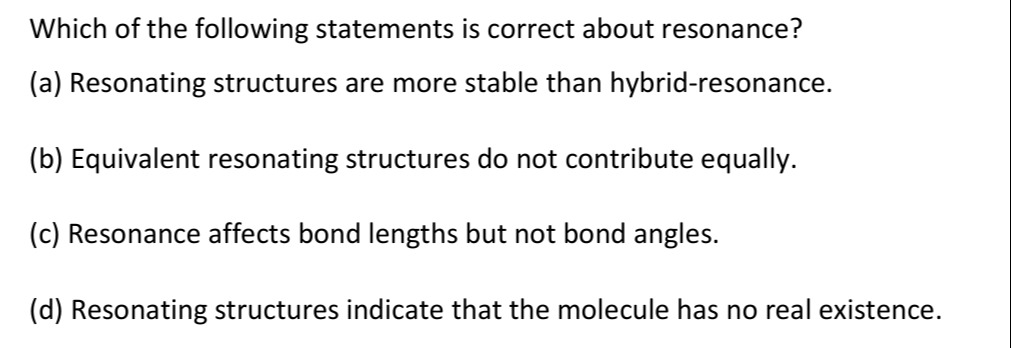Question
Question: Which of the following statements is correct about resonance?...
Which of the following statements is correct about resonance?

Resonating structures are more stable than hybrid-resonance.
Equivalent resonating structures do not contribute equally.
Resonance affects bond lengths but not bond angles.
Resonating structures indicate that the molecule has no real existence.
Resonance affects bond lengths but not bond angles.
Solution
Let's analyze each statement about resonance:
(a) Resonating structures are more stable than hybrid-resonance. This statement is incorrect. The resonance hybrid, which represents the actual molecule, is more stable than any of the individual contributing resonance structures. The difference in energy between the most stable contributing structure and the resonance hybrid is called resonance energy, which is a measure of the extra stability due to resonance.
(b) Equivalent resonating structures do not contribute equally. This statement is incorrect. When a molecule can be represented by two or more equivalent resonance structures (structures with identical energies), these structures contribute equally to the resonance hybrid. If the contributing structures are non-equivalent, they contribute unequally, with the more stable structures contributing more.
(c) Resonance affects bond lengths but not bond angles. This statement claims that resonance affects bond lengths but not bond angles. Resonance involves the delocalization of electrons, which leads to the averaging of bond orders between atoms. This directly affects bond lengths, making them intermediate between single and double (or triple) bonds. For example, in benzene, all C-C bond lengths are equal and intermediate between single and double bond lengths. Regarding bond angles, resonance can influence the electron distribution and geometry of a molecule, which can indirectly affect bond angles. For instance, the planarity of the peptide bond is attributed to resonance, which restricts rotation around the C-N bond and influences the bond angles to maintain the planar arrangement. Therefore, claiming that resonance does not affect bond angles is strictly incorrect. However, in many introductory contexts, the primary and most direct effect of resonance discussed is the averaging of bond lengths and increased stability. The effect on bond angles might be considered secondary or less direct compared to the effect on bond lengths. Given that options (a), (b), and (d) are definitively false, option (c) is likely intended to be the correct answer, focusing on the direct effect of resonance on bond lengths.
(d) Resonating structures indicate that the molecule has no real existence. This statement is incorrect. The molecule does have a real existence, and it exists as the resonance hybrid. The resonance structures are theoretical or hypothetical representations used to describe the electron distribution in the molecule; they do not represent the actual molecule itself.
Considering the analysis, statements (a), (b), and (d) are clearly false. Statement (c) is not strictly accurate regarding bond angles, as resonance can influence geometry. However, in the context of multiple-choice questions where other options are unequivocally wrong, statement (c) is the most plausible correct answer, emphasizing the primary effect of resonance on bond lengths.
